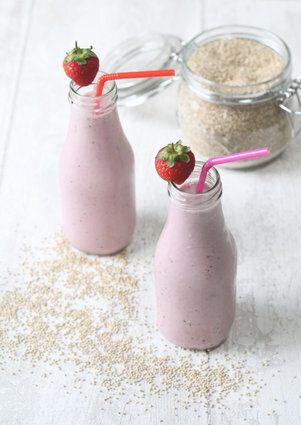
I LOVE getting my day off to an energized start, and I never miss breakfast, ever. Eating breakfast provides us with the energy and nutrients that lead to increased concentration, and can contribute to maintaining a healthy body weight.
Even if you've never taken your mom's advice that breakfast is the most important meal of the day, there's still time to form the habit!
I'm really big on protein-rich breakfasts, as they stabilize blood sugar, and one great protein-rich breakfast option I've discovered recently is quinoa. Yes, that's right, quinoa for breakfast!
Quinoa is amazing, and versatile. It is gluten-free and contains iron, B-vitamins, magnesium, phosphorus, potassium, calcium, vitamin E and fibre. It is one of only a few plant foods that is a complete protein and has all nine essential amino acids.
So, why limit quinoa to lunch and dinner? I officially declare it a Smart breakfast food. Introducing, the Quinoa Breakfast Bowl! It is loaded with fibre and protein to keep you fueled for your day.
If you're not yet convinced, here are my top five reasons that people should eat more quinoa... every meal even!
- Quinoa is high in fibre. Quinoa contains between 10 and 16 grams of fiber, per every 100 grams of uncooked quinoa, or 17-27 grams per cup, which is very high. While most of the fibre is insoluble fibre, it still has about or 1.5 grams of soluble fibre per 100 grams. Numerous studies have shown that soluble fibre can help reduce blood sugar levels, lower cholesterol, increase fullness and help with weight loss.
- Quinoa is naturally gluten free. Using it instead of typical gluten-free ingredients can increase the antioxidant and nutrient value of a gluten-free diet. Using quinoa instead of highly refined gluten-free ingredients like refined tapioca, potato, corn and rice flour can increase the nutrient value of the diet.
- Quinoa is low glycemic. The glycemic index measures how quickly foods raise blood sugar levels. Eating foods that are high on the glycemic index can stimulate hunger and contribute to obesity. Quinoa has a glycemic index of 53, which is considered low.
- Quinoa is high in antioxidants.Antioxidants neutralize free radicals and are believed to help fight ageing and many diseases. Allowing quinoa seeds to sprout likely increases the antioxidant content further. Quinoa is also great for hair, nourishing it with protein to reduce breakage for healthier looking fuller hair.
- Quinoa is easy to make, and can be eaten for breakfast, lunch or dinner! Quinoa can be found everywhere now, and takes about half the time to cook that does rice. Its grains are slightly nutty in taste and become fluffy with a small tail when cooked. Use it in stir fries, burgers, bars, cookies, salads and more! It can also be sprouted and used in healthy salads, or can be found in cereals and snacks in puffed form.
To cook the whole grain, use one part quinoa and two parts liquid, bring to a boil and cook covered in a pot until the liquid is absorbed, about 15 minutes. One cup of dry quinoa yields approximately three cups cooked.
Follow HuffPost Canada Blogs on Facebook
ALSO ON HUFFPOST:
